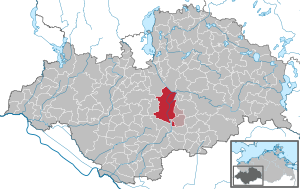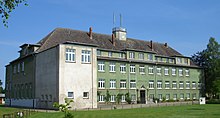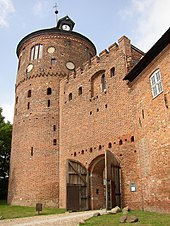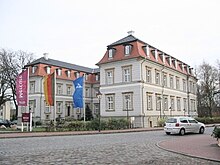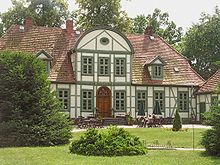Neustadt-Glewe
| coat of arms | Germany map | |
|---|---|---|
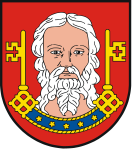
|
Coordinates: 53 ° 23 ' N , 11 ° 35' E |
|
| Basic data | ||
| State : | Mecklenburg-Western Pomerania | |
| County : | Ludwigslust-Parchim | |
| Office : | Neustadt-Glewe | |
| Height : | 34 m above sea level NHN | |
| Area : | 93.98 km 2 | |
| Residents: | 7032 (December 31, 2019) | |
| Population density : | 75 inhabitants per km 2 | |
| Postal code : | 19306 | |
| Area code : | 038757 | |
| License plate : | LUP, HGN, LBZ, LWL, PCH, STB | |
| Community key : | 13 0 76 105 | |
| LOCODE : | DE NGL | |
| City structure: | 8 districts | |
City administration address : |
Market 1 19306 Neustadt-Glewe |
|
| Website : | ||
| Mayoress : | Doreen Radelow ( SPD ) | |
| Location of the city of Neustadt-Glewe in the Ludwigslust-Parchim district | ||
Neustadt-Glewe (until 1926: Neustadt i. Meckl. ) Is a town in the Ludwigslust-Parchim district in the southwest of the German state Mecklenburg-Western Pomerania . It is the seat of the Neustadt-Glewe office . The city is part of the Hamburg metropolitan region and functions as a basic center for its surroundings .
geography
Geographical location
The city is located on the southern edge of the Lewitz , about 30 kilometers south of the state capital Schwerin . At the northern city limits, the Stör Canal flows into the Müritz-Elde waterway . The latter feeds the large Friedrichsmoorer and Neuhöfer carp ponds in the north of the district and flows through the city together with its two branches. The New Canal is one of the numerous trenches that run through the Lewitz . The Neustädter See is located northwest of the built-up urban area . The nature reserves Fischteiche in Lewitz , Friedrichsmoor and Töpferberg are within the city limits .
Surrounding communities are Brenz , Blievenstorf , Muchow , Groß Laasch , Wöbbelin , Rastow , Banzkow , Tramm , Parchim and Spornitz .
City structure
According to its main statute, the districts Friedrichsmoor, Hohewisch, Hohes Feld, Klein Laasch , Kronskamp, Neuhof and Tuckhude belong to the city in addition to the core city .
Separated by a narrow strip of territory belonging to Blievenstorf, the Wabel residential area and its surroundings form an exclave of the city.
history
Surname
Glewe was an old Polish village, and the name Chlěvy - later Chlewa - meant something like 'stable' in Polish or Czech. In 1248 a new founding took place as Noua Civitas, so as a new town , and so the place is called together with the old name 1253 as NC Chlewa or 1265 as NC que Gh (l) iwe and 1300 as NC Glewe .
After that, the altname accounted for a long time, and it was only in 1317 Nyenstat, 1331 Nigenstad or 1337 Nigestat , the old Saxon nigi or ni (g) e stands for new. It was not until 1926 that the city took up the old name again and has been called Neustadt-Glewe since then.
middle Ages
In 1248 the Nova Civitas ( New City ), which originally emerged from a Slavic settlement Chlewa , was first mentioned in the county of Schwerin . As a civitas , it obtained city rights . Due to the location between Elde and a branch of this river, the construction of a city fortification was not necessary. In 1333 the city limits were confirmed. Neustadt became a country town in Mecklenburg and was represented on state parliaments as part of the towns of the Mecklenburg District until 1918 .
The castle , security and defense system of the county and today the town's landmark, was built in the middle of the 13th century to protect the southwestern border of the county of Schwerin. From 1358 the old castle served as a bailiwick and until the 18th century as a secondary residence of the Mecklenburg dukes. Neustadt was pledged in 1391 to the knight Heinrich von Bülow called Grotekop and his brothers. The early Gothic St. Mary's Church was built in the 14th century. The village of Kietz was first mentioned in 1407 . From 1500 the castle was established as a ducal palace.
Trade and industry in the 16th and 17th centuries
Due to the occurrence of lawn iron ores , iron smelting played an important economic role from the 16th to the 18th century . The existing river system and the extensive forest areas of the Lewitz represented favorable conditions for this "woody" branch of industry. In addition to coal, charcoal was an energy source for iron smelting. In the period from around 1512 to 1570, factories and commercial facilities such as an iron smelter, a foundry, a nail and hammer forge, the fulling and paper mill as well as tanneries, powder, grain and saw mills were built in Neustadt. In 1592 a copper and brass smelter was added. A town hall was first mentioned in 1576. Unsustainable timber management ultimately led to the last iron smelter in Neustadt closing in 1717 due to a lack of wood. The forests in the area were almost completely cut down by the ironworks. The Friedrichsmoor Forestry Office, which has existed since 1709, has been responsible for reforestation on parts of the Lewitz over the years.
1600 to 1900
Construction of the New Palace began in 1619 and was only completed in 1717. In 1629, the general Wallenstein visited Neustadt as Duke of Mecklenburg.
- City fires again and again
1664 was the first city fire. In 1671 a town hall on the market was mentioned, which was soon demolished. In 1694 there was a second city fire. In 1720 a second town hall was built. In 1728 many houses and the town hall fell victim to the flames. In 1741 the Kietz district burned down almost completely.
The third town hall was built from 1802 to 1806 in the baroque style as a half-timbered house on the 30 x 40 meter market square. The many city fires favored the reconstruction of the old town with numerous half-timbered houses still preserved today. In 1725, after the second construction phase , Duke Christian Ludwig II moved into the palace after his Grabow residence had burned down in a town fire .
In 1810 the second Parchimer Gate was built. In 1878 the Horney dextrin and starch factory was established. After the rail connection in 1880, the city grew beyond its medieval borders. In 1882 the technical center was founded in the castle and in 1891 the castle brewery Neustadt i / M. The Schulze cement works was built in 1891, and the technical center was given a training workshop in 1894. The city has now been gradually electrified. In 1895 the Centralanstalt for Agricultural Machinery was established by Horney and Rödler. In 1898 the Schwerin Gate was torn down.
From 1900
In 1911 the leather works "Adler & Oppenheimer" were founded. In 1922, the inner-city power station went into operation. In 1926, after about 300 years, the city again gave itself the addition of "Glewe". In 1927 the elementary and middle school was rebuilt on the foundation walls of the former Johann Albrecht works and in 1928 that of the water works near the lake. In 1935 the neighborhood was incorporated again. The technical center closed in 1938. An airfield facility ( Neustadt-Glewe airfield ) was built.
During the period of National Socialism , the Jews living in the city were persecuted, deported and murdered. The Jewish cemetery was destroyed after the November pogrom in 1938 . Around 1942, a subsidiary of the North German Dornier-Werke (Wismar), where parts of the Fw 190 fighter plane were built and assembled, was established not far from the air base and the Nazi pilot school . By September 1944, a satellite camp of the Ravensbrück concentration camp for 300 prisoners, the Neustadt-Glewe concentration camp , was built on the east side of the airfield on the Fliegerchaussee . The approximately 900 female prisoners at the end of 1944, mainly from Poland and Belarus , had to do forced labor in aircraft production. From January 1945, the satellite camp also began so-called evacuation transports from concentration camps to the east. With up to 5000 prisoners, the capacity limit was far exceeded despite the expansion. The Red Army liberated the camp on May 2, 1945. Many of the prisoners, over 500 women and girls, did not survive the difficult-to-describe living conditions in the camp.
From 1952 to 2011 Neustadt-Glewe belonged to the Ludwigslust district (until 1990 in the GDR district of Schwerin , then in the state of Mecklenburg-Western Pomerania ). Since the district reform in 2011 , the city has been in the Ludwigslust-Parchim district .
In 1955 the construction of the new lock and the bridge were completed. From 1967 to 1971, Friedrichsmoor, Hohewisch, Klein Laasch, Kronskamp, Neuhof and Tuckhude were incorporated. In 1970 the new waterworks was built on the outskirts in the direction of Neuhof. From 1972 the development and construction of the home and residential area south and from 1975 that of the prefabricated housing estate on what was then Leninstrasse. Due to the leather, telecommunications and hydraulic works, Neustadt-Glewe was considered an industrial location in GDR times. With the construction of the Hamburg – Berlin transit motorway , the city received a motorway connection in 1982 .

Test drilling from 1987/88 led to the use of the underground thermal water . A geothermal heating plant was built by 1994, supplying a residential area and, from 2010, the city center with district heating, and by 2007 also supplying the leather plant with process heat. In 2003 the first German geothermal power plant went online.
After the political change , the historic city center with the old castle was fundamentally renovated as part of urban development funding. In 1997 the castle was converted into a hotel, and in 1998 the senior citizens' residence at the castle was inaugurated. The contaminated sites of the leather factory, which are problematic for the environment, such as the company landfill and the sewage treatment plant field, made measures to remedy these problems necessary. The new sewage treatment plant was also operational from 1997. In 2002 the old house of the castle collapsed and was reconstructed in 2005/06. The Lederwerk business park was planned and implemented from 2003 to 2007.
Population development
|
|
religion
- There is an Evangelical Lutheran parish with around 1,100 members. It belongs to the Parchim Propstei in the Mecklenburg parish of the Evangelical Lutheran North Church and uses the early Gothic St. Mary's Church on Kirchplatz.
- The Catholics belong to the parish of St. Helena and Andreas in Ludwigslust , Archdiocese of Hamburg . At the Kiez in Neustadt-Glewe there is the St. Ansverus branch church and a day care center run by the parish.
politics
City council
The city council of Neustadt-Glewe consists of 18 members. Since the local elections on May 26, 2019, it has been composed as follows:
| Party / list | Seats |
|---|---|
| CDU | 7th |
| SPD | 6th |
| The left | 4th |
| Individual applicant Axel Kröger | 1 |
mayor
- 2011–2015: Arne Kröger (independent)
- since 2015: Doreen Radelow (SPD)
Radelow was elected in the mayoral election on July 12, 2015 with 51.0 percent of the valid votes.
coat of arms
|
Blazon : "In the Red hersehende, silver haired and bebartete length portrait of a man in the neck, a blue Gewandsaum lined golden and topped with five golden florets, beseitet of two golden keys with averted beards."
The coat of arms was redrawn in 1995 by Hans-Frieder Kühne from Barsbüttel . It was set on April 10, 1858 by Grand Duke Friedrich Franz II of Mecklenburg-Schwerin, the change of coat of arms was approved by the Ministry of the Interior on June 9, 1995 and registered under No. 75 of the coat of arms of the state of Mecklenburg-Western Pomerania. |
|
| Justification of the coat of arms: The coat of arms is based on the seal image of SIGILLVM NOVE CIVITATIS GLEWE - first handed down as an imprint in 1300 - and was established in April 1858. The explanation of the coat of arms restored and revised according to the oldest seal image is still somewhat controversial. The half-length portrait in unity with the keys could indicate the apostle Peter as the patron saint of the city and the fishermen. However, it cannot be ruled out that the bust was interpreted as a speaking symbol for the Slavic place name (gleva = head). |
- Historical city arms
|
Blazon : "In the shield, split by blue and red, emerging from the lower edge, a silver officer's pontoon and an upright silver scythe leaf are crossed at an angle."
The coat of arms was designed by Prof. Hans Herbert Schweitzer from Berlin . It was awarded on January 2, 1941 by the Reich Governor in Mecklenburg. |
|
| Justification of the coat of arms: The coat of arms lost its validity soon after the end of World War II. |
|
Blazon : “Split between blue and red; in it the silver contours of a bearded man's head and two upright keys on its sides. "
The coat of arms was redesigned in 1973 on the occasion of the 725th anniversary of the city based on the old seal image. |
|
| Foundation of the coat of arms: The oldest seal of the city dates from the year 1300 and shows a large male head with parted, long hair and a full beard, accompanied by two upright, outward-facing keys. It bears the inscription SIGILLVM NOVECIVITATIS GLEW. Presumably there is a talking seal picture, because "Glewe" is of Slavic origin and means something like "head" or "head". The meaning of the keys is unclear. |
flag
The flag was approved by the Ministry of the Interior on August 8, 1997.
The flag is evenly striped lengthways. The upper strip is divided into a square red upper corner and a yellow flying end, the lower strip into a square yellow corner on the leech and a red flying end. The Obereck is covered with the figures of the city coat of arms in flag-appropriate tinging: with a facing, white haired and bearded bust of a man, on the neck a blue garment hem, lined with yellow and covered with five yellow roses, accompanied by two yellow keys with turned away beards. The figures take up a total of seven ninths of the height of the upper corner. The length of the flag is related to the height as 5: 3.
Official seal
The official seal shows the town's coat of arms with the inscription "• STADT NEUSTADT-GLEWE • LANDKREIS LUDWIGSLUST-PARCHIM".

Town twinning
Neustadt-Glewe is a member of the international city friendship “Arbeitsgemeinschaft Neustadt in Europa ” with 37 members from seven countries (Germany, Austria, Hungary, Poland, the Czech Republic, Slovakia, the Netherlands) who promote tourism, trade and gastronomy and above all the To promote interpersonal relationships. The annual Neustadt meeting took place in 1998 in Neustadt-Glewe. In addition, the town has been twinning with Oststeinbek near Hamburg since 1991 . A sign near the castle with the inscription "Oststeinbek 111 km" indicates this.
Sights and culture
Buildings
Old castle
The building, which was built in the middle of the 13th century and is one of the best preserved castles in Mecklenburg, is first mentioned in documents from 1331 and served to secure the south-western border of the County of Schwerin and to control the roads and fords of the Elde and the nearby Lewitz area. The structure was restructured in the 14th and 15th centuries. The castle was used for teaching until the 1920s. During the GDR era, there was a youth hostel and apartments here. Today the castle houses a museum about the castle history.
New lock
Not far from the castle is the New Castle on the western branch of the Elde. Construction began in 1619, but the work was stopped in 1624 and was completed in 1717. It was the residence of the future Duke Christian Ludwig II from 1725 to 1735. The stucco ceilings restored by Polish specialists are worth seeing .
town hall
The half-timbered building , built from 1805 to 1806, was renovated from 1993 to 2000 and has a tower with a clock tower. The paved square in front of the town hall and framed by half-timbered buildings serves, among other things, weekly markets.
Marienkirche
The early Gothic , towerless and single-nave brick building with a three-sided east end was built in the 14th century and has been redesigned several times. The west gable is designed as a simple glare gable . After a fire in 1728, the church was rebuilt on its foundations. The church bell is located in a half-timbered outbuilding built in the 18th century. The interior decoration includes the wooden pulpit from 1587. It was designed by Tönnies Evers d. J. originally made for the Marienkirche in Wismar and came to Neustadt-Glewe in 1746. The parapet is structured by columns, in the niches Christ and five apostles are represented. The organ from 1873 was made by Friedrich Albert Mehmel and restored in 1996. The organ gallery was built around 1170. The Neustädter Altar, formerly from Lübeck, has been in the Schwerin State Museum since 1841 .
Friedrichsmoor hunting lodge
The half-timbered building in the district of the same name was formerly the hunting seat of the dukes and is now a hotel and restaurant.
Wiesenmeisterei Tuckhude
The building, located in the district of Tuckhude and built in 1862, was the seat of the administrative authority of the ducal court for the Lewitz, which was responsible for maintaining the ditches, paths, bridges, regulating the irrigation and drainage, monitoring the water levels and ensuring the hay harvest . Today the Wiesenmeisterei is an agricultural history educational facility with overnight accommodation. It is located on the European cycle route. You can also get to her on horseback. It is located on an avenue that leads to the Friedrichsmoor hunting lodge.
Various projects were implemented in backyard buildings and in the area behind the Wiesenmeisterei as part of work-integrative and promoting measures for young and older long-term unemployed: a herb and vegetable garden in an ornamental arrangement, small cattle gates, a large clay oven in which bread can be baked , an early medieval pit house (part of the building is located in a square depression), a wooden round house made of wattle and the restoration of a utility building. The yard is stocked with old farm equipment.
The Rostock-based cultural and educational society Balticult has been maintaining its Lewitztor branch in the Wiesenmeisterei since 2007.
Other structures
- City center with many half-timbered houses
- Eldeschleusen
Historical monuments
- Memorial for the women who perished in the subcamp of the Ravensbrück concentration camp, erected in the city cemetery in 1947
- Memorial stone from 1995 in a grove in the extension of the Liebsiedlung for the more than 500 mostly female victims of forced labor in the subcamp of the Ravensbrück concentration camp, at the same time an information board was set up near the airfield and a memorial path was set up to mark the former locations of camp buildings and facilities you can see the remains of a one-man air raid shelter
- Commemorative plaque for the Social Democratic Reichstag member Rudolf Breitscheid , who died in the Buchenwald concentration camp in 1944 , in the street named after him (No. 2) from the 1960s
- Old oak in Neuhöfer Straße, reminds of the Jewish cemetery formerly located there, which was removed by the Nazis .
- Soviet cemetery of honor on the west bank of the Neustädter See for soldiers of the Red Army
- Not available anymore
- Memorial plaque from 1954 on the Strasse des Friedens (today: Laascher Strasse) for the communist trade unionist August Apfelbaum, who died in 1945 in the Sachsenhausen concentration camp . The leather factory named after him was dismantled after 1990 and the panel removed.
- Former war memorial from the First World War on Schloßplatz, which was dedicated to the Scholl siblings in 1969 . The memorial and the square, which was named after them in GDR times, lost their name after 1990. The memorial was demolished in 2011.
- War memorial of the First World War for teachers and students of the technical center near the lake, removed after 1945
- Memorial stone for the communist politician Ernst Thälmann on the square named after him in GDR times. The stone was razed and the square was now renamed after the Scholl siblings who moved away from the Schlossplatz.
- Memorial plaque for Ernst Thälmann on a house in Thälmannstrasse, removed after 1990
nature
- Lewitz nature and landscape protection area
- Neustädter See in the north-west of the city with flat sandy shores and a bathing establishment with a pier. In the immediate vicinity of the lake there is a campsite, holiday and weekend settlements as well as some dining facilities.
Regular events
- Airbeat One , the largest dance festival in Northern Germany
- Castle festival with medieval hustle and bustle in June
- Shooting festival in September
Economy and Infrastructure
Companies
The economic structure of Neustadt-Glewe is characterized by medium-sized companies. After 1990, large, unprofitable companies such as VEB Lederwerk “August Apfelbaum” and VEB Fernmeldewerk were wound up . The once most important company was the leather factory of the former Adler & Oppenheimer AG (from 1940/41 "Aryanized" as Norddeutsche Lederwerke ). During the GDR era, up to 1700 people were employed in the leather factory. Most recently the company operated under the name Nordleder GmbH . Leather production was finally stopped at the end of September 2007. Then the 24 hectare industrial and commercial area Lederwerk was developed there. An industrial park on the A 24 motorway was inaugurated in the early 1990s .
Important companies in Neustadt-Glewe are:
- AcryliCon Polymers GmbH
- Concrete plant Neustadt-Glewe GmbH
- Carmaxx Automobil eK - restoration of classic automobiles
- Dockweiler AG (stainless steel pipe systems and stainless steel processing)
- Forwarding companies, including a branch of the forwarding and logistics company Paul Schockemöhle
- FNG GmbH (precision mechanics)
- GLS General Logistics Systems Germany GmbH & Co. OHG (Depot 19)
- Henkel Beiz- und Elektropoliertechnik GmbH & Co. KG (stainless steel processing)
- Land-Service Gesellschaft Neustadt-Glewe mbH
- MBP Medical Biomaterial Products (medical products made from collagen)
- OECO Büromöbelwerke Oelschlägel & Co. GmbH
- Wilhelm Hoyer GmbH & Co. KG Energieservice Mecklenburg
Public facilities
- Town hall (seat of the city council and the Neustadt-Glewe office)
- City library on the market
traffic
Street
Neustadt-Glewe is on the L 073 state road from Ludwigslust , which continues east of the city as the B 191 federal road to Parchim . State road 71 connects Neustadt-Glewe with Wöbbelin . The closest motorway junction is about two km away from Neustadt-Glewe on the A 24 ( Hamburg - Berlin ).
A local bus company provides public transport connections to surrounding villages and Ludwigslust on weekdays, from where other destinations can be reached by bus or train.
railroad
The station Neustadt-Glewe is located on the railway line Ludwigslust-Parchim by the East German railway company (ODEG) is operated. It is served by the regional train line RB 14 ( Hagenow Stadt - Parchim ). There are connections to long-distance traffic from Berlin to Hamburg and regional traffic to Schwerin and Wittenberge via Ludwigslust train station, nine kilometers away .
water
The Müritz-Elde waterway , through which connections in the direction of Müritz , Elbe and over the Stör Canal in the direction of Schweriner See are possible, is mainly used by hobby boaters today. Directly at the foot of the castle, in the right arm of the river, the local water sports club operates a jetty with 50 berths including sanitary facilities.
There are two locks in the urban area. On the one hand there is the weir system in the Lewitz, located between the districts of Neuhof and Kronskamp at river kilometer 50.56, which is the tenth lock on the Müritz-Elde waterway (seen from the mouth in Dömitz). The lock system No. 9 at kilometer 46.16 near the castle overcomes a difference in altitude of about two meters. It was rebuilt from 1951 to 1955 together with the high bridge, the fairway within the structure measures 54 meters × 6.6 meters . With the renovation in 2004, this lock was converted to self-service operation, and the northern gate entrance, which is well worth seeing and which raised the barrage above the heads of those passing through, has been replaced by a double wing gate.
education
- Elementary school "Johann Wolfgang von Goethe", Thälmannstrasse 22
- Karl-Scharfenberg-Schule (regional school), Laascher Straße 57
Sports
- The SV progress Neustadt-Glewe is represented in several sports. The leather workers' stadium on Laascher Straße and a sports hall (Zur Kuhdrift 1) are available for this purpose.
- At the airfield in the south-east of the city, sport and gliding as well as parachuting are pursued.
Personalities
sons and daughters of the town
- Karl I, Duke of Mecklenburg (1540–1610), Duke in the Mecklenburg-Güstrow region
- Christian Ludwig Behm (1728–1804), Mayor of Rostock
- Karl Bötefür (1875 – after 1945), colonial and administrative officer
- Wilhelm Fredenhagen (1843–1924), machine manufacturer
- Rudolf Kleiminger (1884–1967), local history researcher and educator
- Rudolf Habedank (1893–1969), politician (NSDAP)
- Kurt Bauch (1897–1975), art historian
- Margarete Rabe (* 1923), guard in two German concentration camps
- Ilonka Struve (* 1960), children's book author
Personalities associated with Neustadt-Glewe
- Heinrich Brockmann (1820–1858), doctor in Neustadt
- Heinz Kägebein (1924–2018), writer and local researcher, lived in Neustadt-Glewe
- Henry Gawlick (* 1958), museum director, grew up in Neustadt-Glewe
literature
- Karl Heinz Schütt: On the history of the Jews in Neustadt-Glewe. 1996, ISBN 3-929994-64-X
- Karl Heinz Schütt: A forgotten warehouse. About the Neustadt-Glewe subcamp of the Ravensbrück women's concentration camp . 3 volumes; 1997, 1998, 2001, ISBN 3-932725-07-7 , ISBN 3-89819-073-0 , ISBN 3-89819-074-9
- Heike Weiberg and Elmar Zinke: Profiles from the Ludwigslust district. Ludwigslust, Neustadt-Glewe, Grabow and the surrounding area. 2001, ISBN 3-932746-25-2
Individual evidence
- ↑ Statistisches Amt MV - population status of the districts, offices and municipalities 2019 (XLS file) (official population figures in the update of the 2011 census) ( help ).
- ^ Regional Spatial Development Program West Mecklenburg (2011) , Regional Planning Association, accessed on July 12, 2015
- ↑ § 14 of the main statute (PDF; 4.4 MB) of the city
- ↑ Ernst Eichler and Werner Mühlner: The names of the cities in Mecklenburg-Western Pomerania. Ingo Koch Verlag, Rostock 2002, ISBN 3-935319-23-1
- ↑ Figures from: Neustadt-Glewe and GOS redevelopment agency: Brochure Documentation of a modernization and repair in Neustadt-Glewe. 2003
- ↑ Neustadt Glewe. Parchim parish, accessed on September 24, 2010 .
- ↑ Neustadt-Glewe - St. Ansverus Church. Catholic Parish St. Helena / St. Andreas, accessed on March 18, 2015 .
- ↑ Parish of St. Helena / St. Andreas - Ludwigslust. Archdiocese of Hamburg, archived from the original on August 28, 2010 ; Retrieved September 24, 2010 .
- ↑ Montessori Children's House St. Julie BILLART Neustadt-Glewe. (No longer available online.) Archived from the original on November 2, 2010 ; Retrieved September 24, 2010 . Info: The archive link was inserted automatically and has not yet been checked. Please check the original and archive link according to the instructions and then remove this notice.
- ^ Result of the election for the city council on May 26, 2019
- ↑ Arne Kröger moves into the town hall. In: Schweriner Volkszeitung , January 31, 2011.
- ^ Result of the mayoral election on July 12, 2015
- ↑ a b Hans-Heinz Schütt: On shield and flag - the coats of arms and flags of the state of Mecklenburg-Western Pomerania and its municipalities . Ed .: production office TINUS; Schwerin. 2011, ISBN 978-3-9814380-0-0 , pp. 137-139 .
- ↑ Gert Oswald: Lexicon of Heraldry. Bibliographical Institute, Mannheim / Vienna / Zurich / Leipzig 1984, ISBN 3-411-02149-7 . 3rd unchanged edition: Battenberg, Regenstauf 2011, ISBN 978-3-86646-077-5 , page 342.
- ↑
- ↑ a b main statute § 2 (PDF).
- ↑ Jewish cemeteries in Mecklenburg-Western Pomerania at www.alemannia-judaica.de

